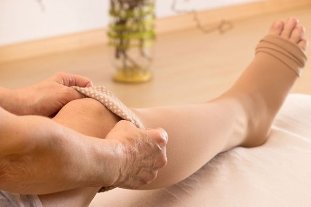Varicose veins - a disease associated with the increase of deformation, and the formation of nodes on the veins near the surface of the body. Most often seen in the legs.

The disease is seen in 20% of women and 10% of men around the world. Early stages of the disease rarely bothers the patient, but it is fraught with great danger to life, because at any moment it may be thrombophlebitis. Blood clots that form in varicose veins can break off and pass into the bloodstream to vital organs and cause death.
Varicose veins are triggered by weakness in the wall and the valve system of the patient. This system circulates blood through the veins of the legs to the heart, but a malfunction of the valve there is a stagnation of blood in the legs and increasing pressure. As a result, the veins become large, weak, and their shape is disturbed.
Varicose veins often affects people who have a genetic predisposition. In addition, the risk of developing the disease increases in people who are overweight, pregnant women, and individuals who spend a lot of time standing up. The most important factor that contributes to the development of the disease - the aging process.
Symptoms
The disease has two forms (primary and secondary).
The primary form of the disease is associated with weakness or a violation of the venous wall. The factors that cause this disease during pregnancy, obesity, congenital weakness of the connective tissue, a long-term stay in a standing position, and also wearing stockings with tight elastic bands.
Symptoms of the primary form of varicose veins:
- fatigue, heaviness, pain and burning sensation in the legs;
- itching vessels;
- swelling of the ankles or legs.
The secondary form of varicose veins due to venous outflow disorders as well as trauma and tumors.
The symptoms in this form are:
- swelling of the legs and feet after prolonged standing or sitting;
- pain in the feet and calves;
- skin changes (increased dryness, discoloration of the skin, reducing the thickness of the skin);
- night cramps in the legs;
- trophic ulcers.
Causes of varicose veins in the legs are:
- hereditary weakness of the vessels;
- lack of exercise;
- long-term static load;
- hormonal disorders, and hormonal drugs;
- leg injuries;
- pregnancy;
- weight lifting, overload;
- Smoking.
Also in danger are:
- athletes, which class are associated with a large load on the foot;
- of the professions, who spend too much time standing (barbers, teachers, waitresses, and others);
- those who work in sitting, especially for people who have used this time to throw a leg over the other;
- women who wear high heels;
- for lovers of coffee and alcohol, as these foods cause dryness, and thus thickens the blood.
If by the end of the day experience mild swelling and the person feels heaviness in the lower limbs, this can be a sign of the beginning of varicose veins in the legs. In addition, should be warned to periodically spasm and pain in the calves. And because of the observable symptoms of varicose veins generally begins with the appearance of spider veins, then there are irreversible processes in the large veins.
Treatment

Treatment of the disease involves the use of drugs to ease the condition or improve the tone of veins. Besides, it is recommended to take vitamins (A, b,C, E) and minerals (magnesium, calcium, zinc, lecithin). The treatment of varicose veins is recommended to use methods, such as:
- microwave resonance therapy;
- UHF (wave treatment);
- magnetic therapy;
- laser treatment;
- acupuncture,
- electroacupuncture stimulation.
However, in severe varicose veins performed sclerotherapy or surgery. Sclerotherapy is the use of special injections of drugs, which leads to the overgrown varicose veins, and surgery involves the removal of the expanded veins.
But experts strongly recommend regular exercise easy prevention of the disease:
- avoid prolonged sun exposure, not to get involved in a hot tub and sauna, as this reduces venous tone and leads to stagnation of blood in the legs;
- lead an active lifestyle, many move and exercise;
- monitor their diet and limit the amount of salt consumed;
- wearing tight clothes, socks or stockings with tight elastic bands, as this leads to compression of the veins;
- do not wear tight shoes and high heels;
- not throw a leg over the other, did not remain long in a sitting or standing position;
- take a contrast shower;
- eat foods rich in fiber to prevent constipation, which also causes the appearance of varicose veins;
- do daily self-massage of the legs;
- perform therapeutic and corrective gymnastics.
Varicose veins of the pelvis
Varicose veins of the pelvis is pathology, which is found mostly in women of childbearing age.
There are two versions of the disease: venous plethora of the pelvis and varicose veins of perineum and vulva. This division is conditional, since more than half of the cases of varicose veins of the pelvis perineum and vulva causes impaired outflow of blood from the veins of the pelvis and vice versa.
Start the mechanism of development of disease is pregnancy. Although susceptibility to this disease can be detected before pregnancy through ultrasound.
Depending on the severity of the disease, the specialist to determine what treatment method to apply: conservative or operative. Varicose veins of the pelvis 1 or 2 degrees often apply conservative treatment (e.g. physiotherapy). And because of the effect of conservative treatment or in the presence of 3. degree of the disease, surgical measures.























